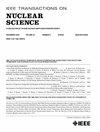Scintillation Properties of CsCu2I3 Perovskite Single Crystal Grown by Room Temperature Solution Processing Method
IF 1.9
3区 工程技术
Q3 ENGINEERING, ELECTRICAL & ELECTRONIC
引用次数: 0
Abstract
Metal halide perovskites have received great interest in developing scintillator materials. Among various types of perovskites, low dimensional metal halide perovskites have high exciton binding energy and photo-luminescence quantum yield (PLQY), making them suitable for X-ray and室温固溶法生长ccu2i3钙钛矿单晶的闪烁特性
金属卤化物钙钛矿在开发闪烁体材料方面受到了极大的关注。在各类钙钛矿中,低维金属卤化物钙钛矿具有较高的激子结合能和光致发光量子产率(PLQY),适用于x射线和γ射线探测。在这项工作中,我们报道了一维ccu2i3单晶的生长和表征(结构和光学)。采用溶剂蒸发法在室温下培养SC。该晶体具有具有Cmcm空间群的正交结构。光学表征表明,由于自捕获激子(STE)发射,产生了具有大斯托克位移(~230 nm)的黄色光致发光(PL)。x射线光电子能谱(XPS)结果表明,油酸(OA)的加入阻止了Cu+的氧化。此外,我们将SC与硅光电倍增管(SiPM)耦合以研究其闪烁特性。生长的晶体具有光输出,能量分辨率,线性和非比例性的特征。本研究中生长的CsCu2I3 SC与文献中报道的使用逆温度结晶(ITC)生长的CsCu2I3 SC具有~20000 ph/MeV的可比光输出。然而,本研究中报道的能量分辨率(在662 keV时为11.57%)优于文献中报道的icc生长晶体的值。利用GEANT4仿真工具包进行了模拟,得到了不同体积CsCu2I3闪烁体的本禀光峰效率,并与NaI:Tl和BGO闪烁体进行了比较。
本文章由计算机程序翻译,如有差异,请以英文原文为准。
求助全文
约1分钟内获得全文
求助全文
来源期刊

IEEE Transactions on Nuclear Science
工程技术-工程:电子与电气
CiteScore
3.70
自引率
27.80%
发文量
314
审稿时长
6.2 months
期刊介绍:
The IEEE Transactions on Nuclear Science is a publication of the IEEE Nuclear and Plasma Sciences Society. It is viewed as the primary source of technical information in many of the areas it covers. As judged by JCR impact factor, TNS consistently ranks in the top five journals in the category of Nuclear Science & Technology. It has one of the higher immediacy indices, indicating that the information it publishes is viewed as timely, and has a relatively long citation half-life, indicating that the published information also is viewed as valuable for a number of years.
The IEEE Transactions on Nuclear Science is published bimonthly. Its scope includes all aspects of the theory and application of nuclear science and engineering. It focuses on instrumentation for the detection and measurement of ionizing radiation; particle accelerators and their controls; nuclear medicine and its application; effects of radiation on materials, components, and systems; reactor instrumentation and controls; and measurement of radiation in space.
 求助内容:
求助内容: 应助结果提醒方式:
应助结果提醒方式:


